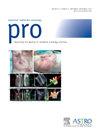Impact of Manual Contour Editing on Plan Quality for Online Adaptive Radiation Therapy for Head and Neck Cancer
IF 3.5
3区 医学
Q2 ONCOLOGY
引用次数: 0
Abstract
Purpose
Online adaptive radiation therapy (oART) has high resource costs especially for head and neck (H&N) cancer, which requires recontouring complex targets and numerous organs-at-risk (OARs). Adaptive radiation therapy systems provide autocontours to help. We aimed to explore the optimal level of editing automatic contours to maintain plan quality in a cone beam computed tomography-based oART system for H&N cancer. In this system, influencer OAR contours are generated and reviewed first, which then drives the autocontouring of the remaining OARs and targets.
Methods and materials
Three-hundred-forty-nine adapted fractions of 44 patients with H&N cancer were retrospectively analyzed, with physician-edited OARs and targets. These contours and associated online-adapted plans served as the gold standard for comparison. We simulated 3 contour editing workflows: (1) no editing of contours; (2) only editing the influencers; and (3) editing the influencers and targets. The geometric difference was quantified using the Dice similarity coefficient (DSC) and Hausdorff distance (HD). The dosimetric differences in target coverage and OAR doses were calculated between the gold standard and these 3 simulated workflows.
Results
Workflow 1 resulted in significantly inferior contour quality for all OARs (mean DSC, 0.85 ± 0.17 and HD95, 3.10 ± 5.80mm); hence, dosimetric data was not calculated for workflow 1. In workflow 2, the frequency of physician editing targets and remaining OARs were 80.8% to 95.7% and 2.3% (brachial plexus) to 67.7% (oral cavity), respectively, where the OAR differences were geometrically minor (mean DSC >0.95 with std ≤0.09). However, because of the unedited target contours of workflow 2 (mean DSC, 0.86-0.92 and mean HD95, 2.56-3.30 mm vs the ground-truth targets), plans were inadequate with insufficient coverage. In workflow 3, when both targets and influencers were edited (noninfluencer OARs were unedited), >95.5% of the adapted plans achieved the patient-specific dosimetry goals.
Conclusions
The cone beam computed tomography-based H&N oART workflow can be meaningfully accelerated by only editing the influencers and targets while omitting the remaining OARs without compromising the quality of the adaptive plans.
人工轮廓编辑对头颈癌在线自适应放疗计划质量的影响
目的:在线自适应放疗(oART)的资源成本很高,尤其是头颈部(H&N)癌症,需要对复杂靶点和众多危险器官(OAR)重新构图。ART 系统提供自动轮廓帮助,我们的目标是探索在基于锥束计算机断层成像(CBCT)的头颈癌 oART 系统中编辑自动轮廓的最佳水平,以保持计划的质量。在该系统中,首先生成并审查影响者的 OAR 轮廓,然后驱动其余 OAR 和目标的自动轮廓绘制:对 44 名 H&N 患者的三百四十九个适应分区进行了回顾性分析,其中包括医生编辑的 OAR 和目标。这些轮廓和相关的在线改编计划作为比较的黄金标准。我们模拟了三种轮廓编辑工作流程:(1) 不编辑轮廓,(2) 仅编辑影响因素,(3) 编辑影响因素和目标。几何差异通过骰子相似系数(DSC)和豪斯多夫距离(HD)进行量化。计算了黄金标准和这三种模拟工作流程在目标覆盖和 OAR 剂量方面的剂量学差异:工作流程 1 导致所有 OAR 的轮廓质量明显较差(平均 DSC 为 0.85±0.17,HD95 为 3.10±5.80mm),因此未计算工作流程 1 的剂量数据。 在工作流程(2)中,医生编辑目标和剩余 OAR 的频率分别为 80.8%-95.7% 和 2.3%(臂丛)-67.7%(口腔),OAR 的几何差异较小(平均 DSC>0.95,std≤0.09)。然而,由于工作流程 2 的目标轮廓未经编辑(与地面实况目标相比,平均 DSC 为 0.86-0.92,平均 HD95 为 2.56-3.30mm),计划覆盖范围不足。在工作流程(3)中,对目标和影响因素都进行了编辑(非影响因素 OAR 未编辑),95.5% 以上的改良计划达到了患者特定的剂量测定目标:基于 CBCT 的 H&N oART 工作流程可以通过只编辑影响因素和目标而省略其余 OAR 来有效加速,同时不会影响适应性计划的质量。
本文章由计算机程序翻译,如有差异,请以英文原文为准。
求助全文
约1分钟内获得全文
求助全文
来源期刊

Practical Radiation Oncology
Medicine-Radiology, Nuclear Medicine and Imaging
CiteScore
5.20
自引率
6.10%
发文量
177
审稿时长
34 days
期刊介绍:
The overarching mission of Practical Radiation Oncology is to improve the quality of radiation oncology practice. PRO''s purpose is to document the state of current practice, providing background for those in training and continuing education for practitioners, through discussion and illustration of new techniques, evaluation of current practices, and publication of case reports. PRO strives to provide its readers content that emphasizes knowledge "with a purpose." The content of PRO includes:
Original articles focusing on patient safety, quality measurement, or quality improvement initiatives
Original articles focusing on imaging, contouring, target delineation, simulation, treatment planning, immobilization, organ motion, and other practical issues
ASTRO guidelines, position papers, and consensus statements
Essays that highlight enriching personal experiences in caring for cancer patients and their families.
 求助内容:
求助内容: 应助结果提醒方式:
应助结果提醒方式:


